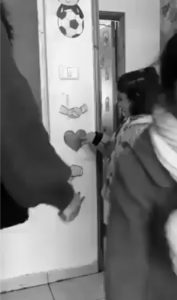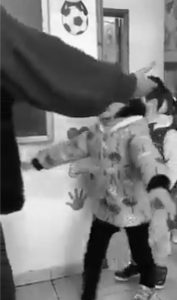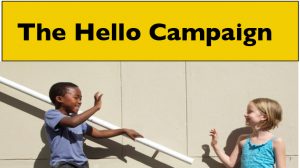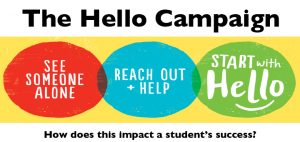“A generous heart is always open, always ready to receive our going and coming. In the midst of such love we need never fear abandonment. This is the most precious gift true love offers – the experience of knowing we always belong.”
―
Pedagogy of Confidence
Critical Thinking Environments:
Belief and Belonging
 A PoC environment opens the potential begins with belief in the learner with creating a space that encourages and supports the belonging for all students. Belief and belonging comes from actions of the educator in creating a room that is one embraces equity consciousness. The students must feel there is belief in their learning, expectations of the highest order, and a sense of belonging with the community. It all begins with a hello, one that opens the hearts and minds of the students to your learning environment.
A PoC environment opens the potential begins with belief in the learner with creating a space that encourages and supports the belonging for all students. Belief and belonging comes from actions of the educator in creating a room that is one embraces equity consciousness. The students must feel there is belief in their learning, expectations of the highest order, and a sense of belonging with the community. It all begins with a hello, one that opens the hearts and minds of the students to your learning environment.
On this page you will see the following examples:
- Welcome to Our Classroom, Our ClassHome, Our Learning Innovator, Our __________
- Hello Greetings with a Choice
—begins the day to set the tone of a Pedagogy of Confidence classroom - The Hello Campaign
—for classroom, school and districts - Mindfulness Instruction Throughout the Day
—attentive to your students and they are learning to be attentive to themselves and peers
Welcome to Our Classroom
Welcome to Our Classhome
Welcome to Our Learning Innovator
Welcome to Our Learning Community
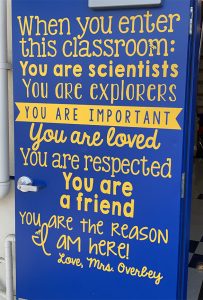
When you are walking through a school, is there a room that says come in as you look at it? Like a store that beckons your interest to buying in their brick and mortar store (or even online), we too can create an environment that says from the entry point and into the learning environment this is your place. Your place we believe in and feel belonging in.
Is there a room that beckons your interest in exploring what might be in that learning environment? It says come into explore and discover. It says there is something of interest. That is the initial entry into a student (and adults) feeling a sense of belief and thus feeding and nurturing a sense of belonging. The Pedagogy of Confidence Environment is an integrative approach with how we function together, the objects that are our classroom home, and the materials that are part of our experience. They must all be part of the feeling that says this is a place to be of belief and belonging.
Hello Greetings with a Choice
There are many video examples on the internet of teachers having simple and elaborate handshakes and similar greetings as they arrive to the classroom. Even a simple hello at the door is more than simply walking in. Why is it important? In the stills and video example below, the students having a choice to the process is essential for the students feeling a part of the decision making and thus their own belief and sense of belonging. It is encouraged for several teachers (really a whole school would be best) implementing concurrently. Then have each class facilitate a discussion of how they could expand this process (other ways, other times, other purposes) and have each class use a visual tool to map their ideas. Then at a staff meeting share the new ideas and keep it growing in the school, school district and community.
The video at the right has the teacher greeting each student as they enter the classroom. What separates this from a simple hello, is the student makes a choice as to how they greet each other.
The Hello Campaign
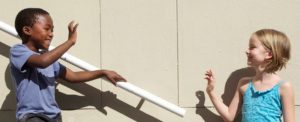 The goal of the school wide ‘Hello Campaign’ is to create a welcoming environment of belonging which then grows the belief of the staff and students. The importance of the Hello Campaign begins with knowing that a community that greets one another is we are in it together in a positive manner. A sequence of implementing the ‘Hello Campaign’ is below to lead initially the whole staff (from bus drivers to board members) and thus modeling within each classroom of students and ultimately the whole school (and district). We are a community of belief and belonging.
The goal of the school wide ‘Hello Campaign’ is to create a welcoming environment of belonging which then grows the belief of the staff and students. The importance of the Hello Campaign begins with knowing that a community that greets one another is we are in it together in a positive manner. A sequence of implementing the ‘Hello Campaign’ is below to lead initially the whole staff (from bus drivers to board members) and thus modeling within each classroom of students and ultimately the whole school (and district). We are a community of belief and belonging.
Step 1: Plan with the leadership team as we must model the model
Powerful Questions about mindfulness
Mindfulness for the school — use a cause / effect map
Map the qualities of mindfulness
Frame the qualities with actions
Everyone’s roles
Step 2: Staff meeting with teachers and support staff
Use the same sequence with the leadership team
Multi-Flow Cause/Effect Map to understand the why
Flow Sequence Map to create an innovation path
Capturing examples in still images and video to share – create displays and kiosks for visitors, parents and the whole school to see
Step 3: Each class is an innovator with modeling and practicing
same innovation model scaffolded for students
Step 4: Parents are welcomed to an evening of practice and innovation
Step 5: Video document
A Mindfulness Movement
—in the Classroom, School, District
The following section is an excerpt from the book Mindfulness Practices. From the forward by Paul Liabenow:
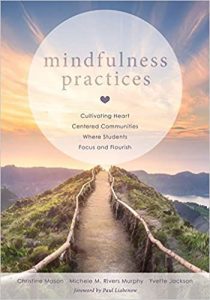 Mindfulness Practices does not present yet another program to follow. It is not an add-on or one more thing to squeeze into our busy days. Rather, the authors advocate for and illustrate change in methods of both being and doing. They provide staff with advice, practices, and exercises to incorporate directly into their teaching, as well as support for activating the benefits of mindfulness for their students—and themselves. Teachers who participated in the Center for Educational Improvement’s (CEI’s) heart centered mindfulness pilot programs in 2017 report that as the foundational practice for cultivating compassionate school environments, mindfulness was a great stress reliever for them, as classroom climates became more positive, with a new calm and sense of renewed enthusiasm and purpose. This new way of being is a new beginning toward directly combating stress, leading to greater compassion, happiness, and success for teachers, administrators, staff, and students. Whether a physical education teacher, health educator, art teacher, special education teacher, school counselor, traditional classroom teacher, or school leader, this book has practical and natural lifelong strategies for you. If this and what follows below sparks your interest from doing, it is highly recommended to use the full book.
Mindfulness Practices does not present yet another program to follow. It is not an add-on or one more thing to squeeze into our busy days. Rather, the authors advocate for and illustrate change in methods of both being and doing. They provide staff with advice, practices, and exercises to incorporate directly into their teaching, as well as support for activating the benefits of mindfulness for their students—and themselves. Teachers who participated in the Center for Educational Improvement’s (CEI’s) heart centered mindfulness pilot programs in 2017 report that as the foundational practice for cultivating compassionate school environments, mindfulness was a great stress reliever for them, as classroom climates became more positive, with a new calm and sense of renewed enthusiasm and purpose. This new way of being is a new beginning toward directly combating stress, leading to greater compassion, happiness, and success for teachers, administrators, staff, and students. Whether a physical education teacher, health educator, art teacher, special education teacher, school counselor, traditional classroom teacher, or school leader, this book has practical and natural lifelong strategies for you. If this and what follows below sparks your interest from doing, it is highly recommended to use the full book.
Mason, Christine; Rivers Murphy, Michele M.; Jackson, Yvette. Mindfulness Practices (p. xvi). Solution Tree Press. Kindle Edition.
“Obstacles, of course, are developmentally necessary: they teach kids strategy, patience, critical thinking, resilience and resourcefulness.”
—Naomi Wolf
An Overview
Are you able to imagine the sensation of the ground giving way gently to the soft imprint your feet make, step by step? If not, we invite you to step outside, barefooted, and feel the earth beneath your feet. Is it warm or cold? Do you feel the blades of grass or the texture of the dirt?
How does this translate to what happens in classrooms as we teach? What would be the equivalent in your day at school? Is it the spark of interest in one student’s eye? The smile that suddenly appears on a face? The air of excitement when students are truly engaged?
Mindfulness in the classroom is not only about teaching mindfulness; it involves being mindful. In chapter 6 (page 91), we take you through a series of exercises to increase your own mindfulness. We also introduce you to initial mindfulness exercises to use in classrooms. Chapter 7 furthers your understanding of mindfulness and its implementation in the classroom by including the following.
- Simple strategies to increase your mindfulness as you instruct
- Mindful activities to incorporate across academic subjects and grade levels
- Compassion challenges and activities
- Examples of how to extend mindfulness to increase compassion within the context of everyday events at school
- Considerations for mindful, compassionate communities
The Why
Consider Who You Are Teaching Mindful
instruction begins with mindful preparation, considering who you are teaching as you prepare your lessons and review material for the next class session. Mindful instruction includes being mindfully present, and listening with your heart and your ears, as you greet each student and help him or her prepare for the day ahead. The suggested activities that follow will help reduce stress and bring basic consciousness or mindfulness to the level of compassion in your classrooms and schools. In this section we start with some basic activities and end with some ways that you can practice handling the more challenging situations.
The How – An Excerpt from the Mindfulness Practices Book
Build Compassion in Classrooms
All the activities in this chapter will help lead to more self-compassion and compassion for others. However, as we all know, sometimes being compassionate is more challenging than at other times. It is one thing to be compassionate when the cost is small and the ask is not too great. For example, it is usually simple to remember to look students in the eye and smile a warm, friendly smile that says, “I care.” It is another thing to be compassionate when a student is noncompliant, disruptive, habitually tardy, or excuse-prone.
Mindful Greetings
As a student enters the classroom, he or she is on the threshold to a new school day. This threshold provides the opportunity to leave unnecessary baggage at the doorstep. A warm greeting from a teacher could be instrumental in setting the tone for a good day at school.
Practice the five-step mindful greeting each day for one week. Record what you discover either in a journal or here, in the pages offered in this book. We recommend that teachers practice this exercise first as a mindfulness meditation and then as they greet students and parents. Follow through by warmly greeting each student and parent with good eye contact and radiating kind, caring thoughts to them.
- Take a few breaths.
- Imagine warmly greeting each student and each parent with direct eye contact and complete attention.
- Imagine being fully present and attentive to possible needs.
- Imagine radiating light to each student and parent.
- Close your eyes and visualize the day ahead.
Mindful Intention
We could say a lot about mindful instruction. As with mindful greetings, you could prepare by visualizing yourself successfully instructing a group of students who are rapt listeners, engaged, and learning. As you visualize this, you could note how you feel when you are connecting with your students. Over the next week, consider visualizing your class the night before you teach. Then as you instruct, take notes on what you learn. The following questions guide you.
• How effective was your hook?
• Did the hook pull students into the lesson?
• Which students were most and least engaged?
• When did your students show the greatest enthusiasm?
• When things did not go as well, what was happening?
• If any behavioral incidents occurred, what were likely catalysts (time of day, hunger, fatigue, boredom, students acting out, tests, disrespect or lack of bonding with you, or peer attention)? How was the timing and pacing of activities?
• How was your voice tone? What message did your voice tone and words convey?
• How was your rapport with students and staff?
• What message does the physical appearance of your room convey?
• What would you change?
Practice mindful instruction (pages 119–122) for a few weeks and see if it impacts your instruction. Perhaps you already considered all of these questions. Have you conducted visualization? Have you considered your body as you ask questions? (Do you feel a knot in your stomach? Fatigue? Impatience? Delight? Confusion?)
It’s important to remember that the goal of mindfulness is not a state of perfection, but a constant ongoing practice of becoming self-aware. Improvement, whether it is in a particular setting, a subject, or during social interaction, takes practice and awareness. Keep in mind that the effectiveness of mindfulness practice stems from the attempt to detach from the daily distractions of everyday life, even our own emotions, and use our senses to live and feel in the present. By practicing this with students, we can help ourselves and our students to learn more about themselves by being able to assess an object, a person, or situation for what it truly is or isn’t. Following are some recommendations of how you can introduce mindfulness across all school subjects to become part of classroom instruction.
Practical Exercises
At some point, after you have practiced a few exercises as introduced in chapters 4–6 (on pages 61, 73, and 91), we recommend that you introduce the terms mindfulness and being mindful to your students and explain their application to everyday life.
With students grades 1 to 4, you may want to use the Mindfulness for Children (n.d.) organization’s definition: “Mindfulness means paying attention to what is happening right now with kindness and curiosity.” With this definition, you could discuss kindness and curiosity, perhaps reading from children’s books in which these are major themes. You might begin a class discussion by saying, “When you are mindful you are aware of others—of what is happening around you. Look around you, what do you see?” As students respond, you can prompt, “Yes, Jennifer is wearing an orange skirt,” or “Kelly did build a really high tower with his bricks,” and so on. Other natural opportunities to discuss mindfulness or being mindful may arise as you discuss seasons of the year with students. When you involve children in nature play or help them observe the seasons, for example, you help them to be more mindful.
You could ask elementary-aged students to spend some time on a daily basis observing their surroundings, perhaps in the neighborhoods where they live. It might help to make this a group activity for a few days. Count how many stores, parks, and cars they see. Or make observations, perhaps even with a graphic organizer as a part of an observational experience in science. Does their neighborhood have a lot of trees? What kind of trees? Are they healthy? Or ask them to observe the weather. What kind of weather do they prefer? Does weather affect how they feel? If so, ask them to try and answer why that is. If they are recording responses, make sure that there is time to share and discuss findings with others. As time goes by, check in with them periodically to get an idea about how they are following through, what they are continuing to observe about their surroundings, and whether you need to adjust your approach. For middle or high school students, consider using Jon Kabat-Zinn’s (2003) definition of mindfulness: paying attention “on purpose, in the present moment, and nonjudgmentally” (p. 145).
Mason, Christine; Rivers Murphy, Michele M.; Jackson, Yvette. Mindfulness Practices (p. 118). Solution Tree Press. Kindle Edition.

